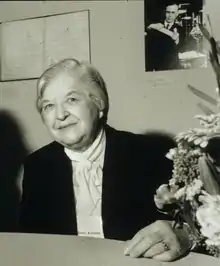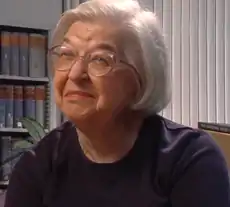Stephanie Kwolek
Stephanie Louise Kwolek (July 31, 1923 – June 18, 2014) was an American chemist who is known for inventing Kevlar. She was of Polish heritage and her career at the DuPont company spanned more than 40 years.[1] She discovered the first of a family of synthetic fibers of exceptional strength and stiffness: poly-paraphenylene terephthalamide.[1][2]
Stephanie Kwolek | |
|---|---|
 | |
| Born | Stephanie Louise Kwolek July 31, 1923 New Kensington, Pennsylvania, United States |
| Died | June 18, 2014 (aged 90) Wilmington, Delaware, United States |
| Nationality | American |
| Alma mater | Carnegie Mellon University |
| Known for | Kevlar |
| Awards | DuPont company's Lavoisier Medal (1995) National Medal of Technology Perkin Medal (1997) Howard N. Potts Medal |
| Scientific career | |
| Fields | Organic chemistry |
| Institutions | DuPont |
For her discovery, Kwolek was awarded the DuPont company's Lavoisier Medal for outstanding technical achievement. As of August 2019, she was the only female employee to have received that honor.[3] In 1995 she became the fourth woman to be added to the National Inventors Hall of Fame.[4] Kwolek won numerous awards for her work in polymer chemistry, including the National Medal of Technology, the IRI Achievement Award and the Perkin Medal.[5][6]
Early life and education
| External video | |
|---|---|
 | |
Kwolek was born to Polish immigrant parents in the Pittsburgh suburb of New Kensington, Pennsylvania, in 1923.[7] Her father, John Kwolek[7] (Polish: Jan Chwałek), died when she was ten years old.[8] He was a naturalist by avocation, and Kwolek spent hours with him, as a child, exploring the natural world.[1] She attributed her interest in science to him and an interest in fashion design to her mother, Nellie (Zajdel) Kwolek, who worked as a seamstress.[3][7][8]
In 1946, Stephanie earned a Bachelor of Science degree with a major in chemistry from Margaret Morrison Carnegie College of Carnegie Mellon University. She had planned to become a doctor and hoped she could earn enough money from a temporary job in a chemistry-related field to attend medical school.[8]
DuPont career
William Hale Charch, a future mentor, offered Kwolek a position at DuPont's Buffalo, New York, facility in 1946.[9] This vacancy was due to men being in the military overseas.[10]
Kwolek only intended to work for DuPont temporarily, to raise money to study. When she found the work interesting, she decided to stay and moved to Wilmington, Delaware, in 1950 with DuPont.[9] In 1959, she won a publication award from the American Chemical Society (ACS), the first of many awards. [5][11][12] The paper, The Nylon Rope Trick,[13] demonstrated a way of producing nylon in a beaker at room temperature. It is still a common classroom experiment,[14] and the process was extended to high molecular weight polyamides.[15] In 1985, Kwolek and coworkers patented a method for preparing PBO and PBT polymers.[16]
Kevlar
While working for DuPont, Kwolek invented Kevlar.[8] In 1964, in anticipation of a gasoline shortage, her group began searching for a lightweight yet strong fiber to replace the steel used in tires.[3][8] The polymers she had been working with at the time, poly-p-phenylene terephthalate and polybenzamide,[17] formed liquid crystal while in solution that at the time had to be melt-spun at over 200 °C (392 °F), which produced weaker and less stiff fibers. A unique technique in her new projects and the melt-condensation polymerization process was to reduce those temperatures to between 0 and 40 °C (32 and 104 °F).[8]
As she later explained in a 1993 speech:[18]
The solution was unusually (low viscosity), turbid, stir-opalescent and buttermilk in appearance. Conventional polymer solutions are usually clear or translucent and have the viscosity of molasses, more or less. The solution that I prepared looked like a dispersion but was totally filterable through a fine pore filter. This was a liquid crystalline solution, but I did not know it at the time.
This sort of cloudy solution usually was thrown away. However, Kwolek persuaded technician Charles Smullen, who ran the spinneret, to test her solution. She was amazed to find that the new fiber would not break when nylon typically would. Not only was it stronger than nylon, Kevlar was five times stronger than steel by weight. Both her supervisor and the laboratory director understood the significance of her discovery, and a new field of polymer chemistry quickly arose. By 1971, modern Kevlar was introduced.[8] Kwolek learned that the fibers could be made even stronger by heat-treating them. The polymer molecules, shaped like rods or matchsticks, are highly oriented, which gives Kevlar its extraordinary strength. Kwolek continued research of thermotropic Kevlar derivatives containing aliphatic and chlorine groups.[19]
Applications of Kevlar
Kwolek was not very involved in developing practical applications of Kevlar.[20] Once senior DuPont managers were informed of the discovery, they immediately assigned a whole group to work on different aspects," she said. Still, Kwolek continued chemistry investigations of Kevlar derivatives for DuPont.[21] She also did not profit from DuPont's products, as she signed over the Kevlar patent to the company.[22]
Kevlar is used as a material in more than 200 applications, including tennis rackets, skis, parachute lines, boats, airplanes, ropes, cables, and bullet-proof vests.[1] It has been used for car tires, fire fighter boots, hockey sticks, cut-resistant gloves and armored cars. It has also been used for protective building materials like bomb-proof materials, hurricane safe rooms, and bridge reinforcements.[22] During the week of Kwolek's death, the one millionth bullet-resistant vest made with Kevlar was sold.[23] Kevlar is also used to build cellular telephones; Motorola's Droid RAZR has a Kevlar unibody.[24]
Awards and honors
For her discovery of Kevlar, Kwolek was awarded the DuPont company's Lavoisier Medal for outstanding technical achievement in 1995, as a "Persistent experimentalist and role model whose discovery of liquid crystalline polyamides led to Kevlar aramid fibers."[25][26] At the time of her death in 2014, she was still the only female employee to receive that honor.[27] Her discovery generated several billion dollars of revenue for DuPont, being her employer at the time, but she never benefited directly from it financially.[22]
In 1980, Kwolek received the Chemical Pioneer Award from the American Institute of Chemists, and an Award for Creative Invention from the American Chemical Society.[5] In 1995,[9][28] Kwolek was added to the National Inventors Hall of Fame.[4] In 1996, she received the National Medal of Technology and the IRI Achievement Award. In 1997, she received the Perkin Medal from the American Chemical Society.[29] In 2003, she was inducted into the National Women's Hall of Fame.[7]
She has been awarded honorary degrees by Carnegie Mellon University (2001),[30] Worcester Polytechnic Institute (1981)[5] and Clarkson University (1997).[31]

The Royal Society of Chemistry grants a biennial 'Stephanie L Kwolek Award', "to recognise exceptional contributions to the area of materials chemistry from a scientist working outside the UK".[32]
Kwolek is featured as one of the Royal Society of Chemistry 175 Faces of Chemistry.[33]
The Star Trek E-book novella Starfleet Corps of Engineers #30: Ishtar Rising references a shuttlecraft named Kwolek.
Retirement
In 1986, Kwolek retired as a research associate for DuPont. Toward the end of her life, she consulted for DuPont, and served on both the National Research Council and the National Academy of Sciences.[9] During her 40 years as a research scientist, she filed and received either 17[20] or 28 patents.[28]
She often tutored students in chemistry.[22] She also devised and wrote about numerous classroom demonstrations that are still used in schools today, such as the Nylon Rope Trick.[34]
Kwolek died at the age of 90 on June 18, 2014.[35]
References
- "Women in Chemistry – Stephanie Kwolek". Science History Institute. Retrieved June 13, 2013.
- Wholly Aromatic Carbocyclic Polycarbonamide Fiber. Original Kevlar patent awarded in 1974 to Stephanie Kwolek.
- Dan Samorodnitsky, "You Can Thank Chemist Stephanie Kwolek for Bulletproof Vests and Yoga Pants," Smithsonian, August 21, 2019.
- "Citation conferring an Honorary Doctor of Science degree on Stephanie Louise Kwolek". University of Delaware. UDaily. May 31, 2008. Archived from the original on May 24, 2009. Retrieved May 24, 2009.
- Bensaude-Vincent, Bernadette (March 21, 1998). Stephanie L. Kwolek, Transcript of an Interview Conducted by Bernadette Bensaude-Vincent at Wilmington, Delaware on 21 March 1998 (PDF). Philadelphia: Chemical Heritage Foundation.
- "SCI Perkin Medal". Science History Institute. Retrieved March 24, 2018.
- "Stephanie Kwolek". Soylent Communications. Archived from the original on May 24, 2009. Retrieved May 24, 2009.
- "Inventing Modern America: Insight — Stephanie Kwolek". Lemelson-MIT program. Archived from the original on May 24, 2009. Retrieved May 24, 2009.
- "Invent Now". National Inventors Hall of Fame. Archived from the original on May 24, 2009. Retrieved May 24, 2009.
- Domonoske, Camila (June 20, 2014). "Stephanie Kwolek, Chemist Who Created Kevlar, Dies At 90". NPR.
- Ferguson, Raymond C. (May 4, 1986). Stephanie Louise Kwolek, Transcript of an Interview Conducted by Raymond C. Ferguson in Sharpley, Delaware on 4 May 1986 (PDF). Philadelphia: Beckman Center for the History of Chemistry.
- Rossiter, Margaret W. (1998). Women Scientists in America. Baltimore, Maryland: Johns Hopkins University Press. p. 267. ISBN 0-8018-5711-2. Retrieved May 24, 2009 – via Google Books.
- Morgan, P. W.; Kwolek, S. L. (1959). "Interfacial polycondensation. II. Fundamentals of polymer formation at liquid interfaces". Journal of Polymer Science. 40 (137): 299–327. Bibcode:1959JPoSc..40..299M. doi:10.1002/pol.1959.1204013702.
- Carlson, Michael (June 28, 2014). "Stephanie Kwolek obituary". The Guardian.
- Morgan, P. W.; Kwolek, S. L. (1975). "Polyamides from Phenylenediamines and Aliphatic Diacids". Macromolecules. 8 (2): 104–111. Bibcode:1975MaMol...8..104M. doi:10.1021/ma60044a003.
- US 4608427, Sweeny, W. & Kwolek, S. L., "PBO and PBT polymers", issued 1986-08-26, assigned to du Pont de Nemours, E. I., and Co., USA.
- "Stephanie Louise Kwolek Biography". Bookrags. Archived from the original on May 24, 2009. Retrieved May 24, 2009.
- Bregar, Bill (June 20, 2014). "Obituary Kevlar inventor Stephanie Kwolek". Plastic News. Retrieved June 21, 2014.
- Kwolek, S. L.; Luise, R. R. (1986). "Thermotropic Liquid Crystalline Aromatic/Cycloaliphatic Polyesters and Fibers". Macromolecules. 19 (7): 1789–1796. Bibcode:1986MaMol..19.1789K. doi:10.1021/ma00161a002.
- Quinn, Jim. "I was able to be Creative and work as hard as I wanted". American Heritage Publishing. Archived from the original on May 24, 2009. Retrieved May 24, 2009.
- Morgan, Paul W.; Pletcher, Terry C.; Kwolek, Stephanie L. (August 29, 1984). "Aromatic Azomethine Polymers and Fibers". Polymers for Fibers and Elastomers. American Chemical Society. pp. 103-114. doi:10.1021/bk-1984-0260.ch007. ISBN 9780841208599.
- Pearce, Jeremy (June 21, 2014). "Stephanie L. Kwolek, Inventor of Kevlar, Is Dead at 90". New York Times. Retrieved June 21, 2014.
- Newcomb, Alyssa (June 20, 2014). "Kevlar Inventor Stephanie Kwolek Dead at 90". Good Morning America – via Yahoo! News.
- Covert, Adrian; Rose, Brent (October 18, 2011). "Motorola Droid RAZR: Thinnest of All. Kevlar. Splashproof. Yes". Gizmodo. Retrieved June 22, 2014.
- "Welcome to the Global Collaboratory: Lavoisier Medal for Technical Achievement" (PDF). DuPont. Retrieved June 22, 2014.
- "Dupont Scientists honored with Lavoisier Medals for technical achievement" (Press release). PRNewswire. April 27, 1995. Archived from the original on July 9, 2014. Retrieved June 22, 2014 – via TheFreeLibrary.
- "Kevlar inventor Stephanie Kwolek dies". BBC News. June 21, 2014. Retrieved December 29, 2019.
- "The History of Kevlar — Stephanie Kwolek". The New York Times Company. About.com. Archived from the original on May 24, 2009. Retrieved May 24, 2009.
- "JCE Online: Biographical Snapshots: Snapshot". Journal of Chemical Education. American Chemical Society. Archived from the original on May 24, 2009. Retrieved May 24, 2009.
- "Obituary: Carnegie Mellon Alumna and Hall of Fame Inventor Stephanie Kwolek Dies at 90". Carnegie Mellon News. Carnegie Mellon University. June 20, 2014. Retrieved October 7, 2014.
- "Honorary Degrees". Clarkson University. Archived from the original on October 12, 2014. Retrieved October 7, 2014.
- "RSC Stephanie L Kwolek Award". Royal Society of Chemistry. Retrieved November 14, 2014.
- Marr, Isobel (July 2015). "Stephanie Kwolek | 175 Faces of Chemistry". Royal Society of Chemistry. Retrieved July 24, 2015.
- Morgan, Paul W.; Kwolek, Stephanie L. (April 1959). "The nylon rope trick: Demonstration of condensation polymerization". Journal of Chemical Education. 36 (4): 182. Bibcode:1959JChEd..36..182M. doi:10.1021/ed036p182.
- "Kevlar inventor Stephanie Kwolek dies at 90". Delawareonline.com. Retrieved June 19, 2014.
Further reading
External links
| Library resources about Stephanie Kwolek |
| By Stephanie Kwolek |
|---|
![]() Media related to Stephanie Kwolek at Wikimedia Commons
Media related to Stephanie Kwolek at Wikimedia Commons
- Stephanie Kwolek at Famous Women Inventors
- "Women in Chemistry – Stephanie Kwolek (Video)". Science History Institute.
- Ferguson, Raymond C. (May 4, 1986). Stephanie Louise Kwolek, Transcript of an Interview Conducted by Raymond C. Ferguson in Sharpley, Delaware on 4 May 1986 (PDF). Philadelphia: Beckman Center for the History of Chemistry.
- Bensaude-Vincent, Bernadette (March 21, 1998). Stephanie L. Kwolek, Transcript of an Interview Conducted by Bernadette Bensaude-Vincent at Wilmington, Delaware on 21 March 1998 (PDF). Philadelphia: Chemical Heritage Foundation.
- Oral history interview with Stephanie L. Kwolek (1986) from Science History Institute Digital Collections
- Oral history interview with Stephanie L. Kwolek (1998) from Science History Institute Digital Collections
- Stephanie L. Kwolek papers at Hagley Museum and Library.
- Stephanie Kwolek photographs and videotapes at Hagley Museum and Library.
- Stephanie Kwolek photographs at Hagley Museum and Library.
